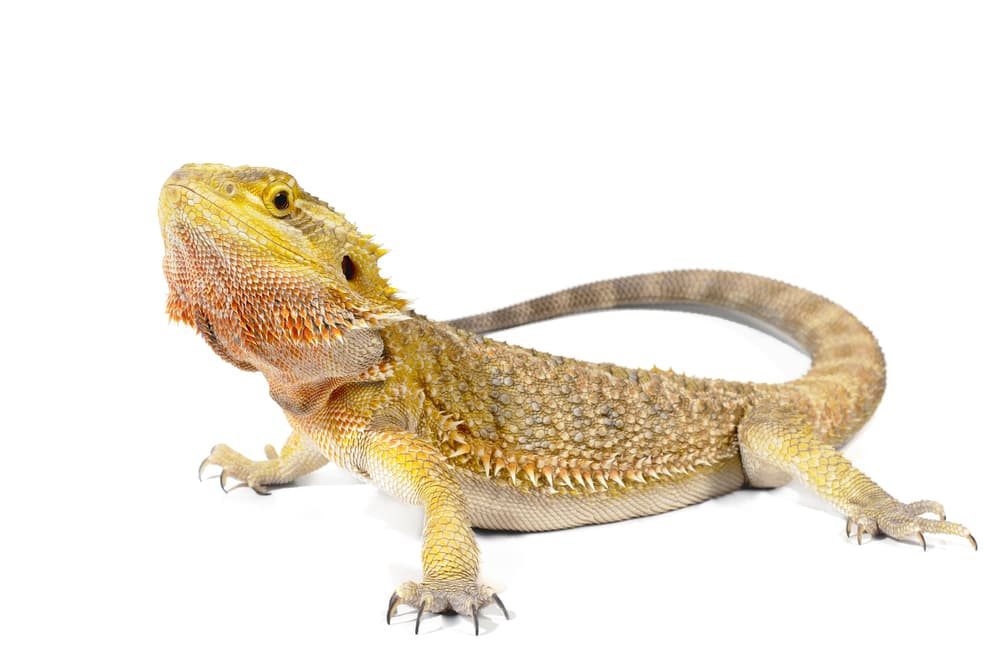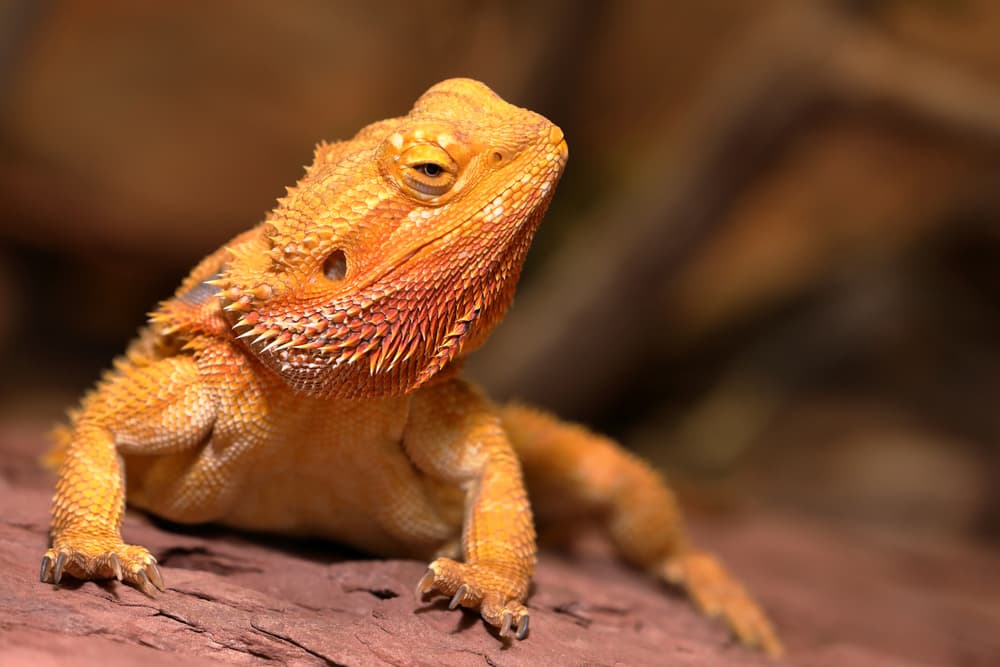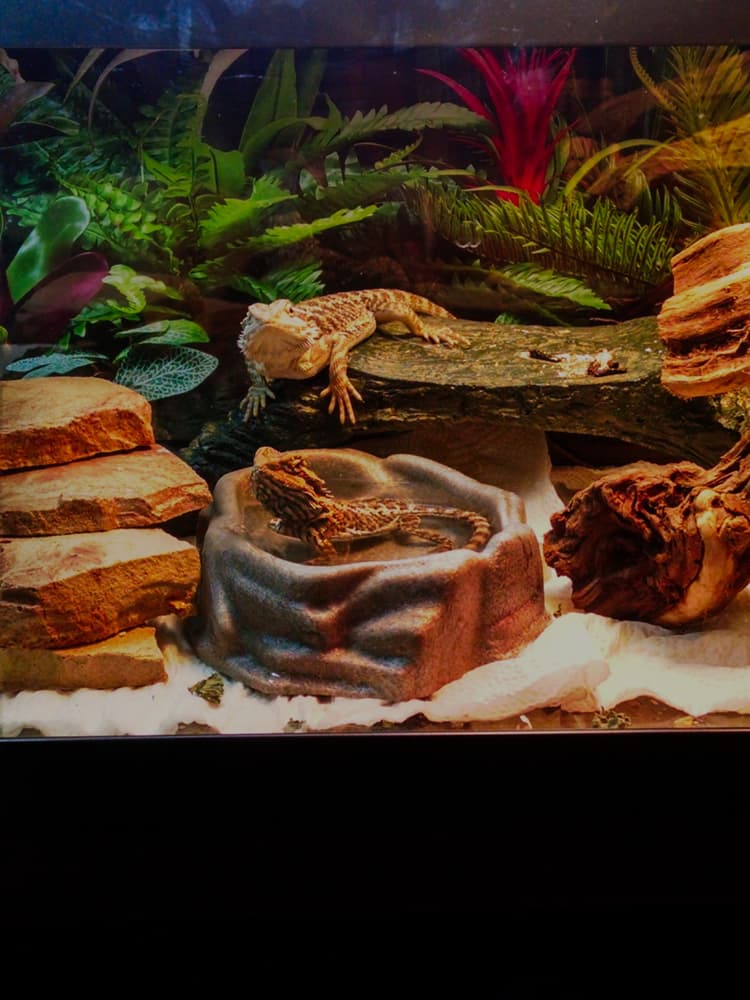Bearded Dragon Care Guide
Bearded Dragon (Pogona vitticeps)
Do you own a bearded dragon or are you considering getting one? Knowing how to take care of your bearded dragon is vital for being a great reptile parent!
Bearded dragons make amazing pets, they are perfect for beginners and experienced reptile keepers. However, in order to ensure your pet thrives, you must meet your bearded dragon’s needs, including an appropriate diet and an environment that mimics natural habitat conditions.
At Jabberwock Reptiles, we are a reptile-focused pet store, located in Massachusetts. We have been providing high-quality reptile pets and knowledge in Massachusetts for years. We can help you provide the best quality of life for your current or future pet. Keep reading and learn more about bearded dragon care from our experts!

Bearded Dragons as Pets

Before we get into the specifics of our bearded dragon care guide, you first need to know a few key details about the species itself. Do they make good pets? How long do they live? We answer all of that below!
Species Info
Bearded dragons, or beardies as reptile lovers like to call them, are small-medium sized lizards native to Australia. As a species relatively low on the food chain, bearded dragons have evolved a variety of bluff defenses such as flimsy spikes, the ability to puff out their throat, and to flatten out their body to appear as large as possible. Beardies are well known for their docile nature and are generally very agreeable when it comes to handling.
Level of Care
Easy overall hardiness. Beardies are not hard to handle or care for, nor do they have extravagant needs. Thanks to their small-medium size, beardies make excellent starter reptiles. So, don’t worry if you’ve never owned a bearded dragon before, they are great pets for beginner reptile owners.
How Long are Bearded Dragons?
Adult beardies tend to be between 18-22 in. long, with males generally being the slightly larger sex.
What is the Lifespan of a Bearded Dragon?
Beardies can live 9-15 years with proper husbandry. Meeting all your pet bearded dragon’s needs, including habitat and dietary requirements is the best way to help your beardie live a long and healthy life.
Contact us now!
Fill the form below and we will contact you shortly or please call 781-729-0135
Ideal Habitat Conditions for Bearded Dragons

Beardies require great care when it comes to their habitat conditions. They have temperature, humidity, lighting, and space requirements that are vital for their quality of life and development. Every beardie owner should be aware of these conditions to take care of their bearded dragon properly.
What is the Ideal Temperature for a Bearded Dragon?
Beardies require a temperature gradient inside the tank, with the hot side being 85-100 degrees and the cool side being 70-85 degrees. The hot side should also have a basking spot that is 100-110 degrees for babies and 95-100 as adults.
Babies should be given a bath in 90-100 degree water every few days, and adults should get one about once a week (5-10 minutes for both).
How Humid Should a Bearded Dragon Tank Be?
Humidity inside the cage should ideally stay between 30 and 40%, but brief periods of percentage spikes aren’t usually cause for concern.
What Kind of Light Does a Bearded Dragon Need?
Beardies need a UV bulb shining on as much of the tank as possible. In the wild, beardies get heat and light from the sun. For an enclosure to mimic the sun’s benefits, high ultraviolet lights, UVA, and UVB lights are necessary.
What Size Tank Do You Need for a Bearded Dragon?
Adult bearded dragons should be housed in at least a 40 gallon terrarium, but babies and juveniles can potentially become stressed in an enclosure of that size. An easy solution to not buying multiple tanks is to wall off part of a large enclosure with a piece of cardboard.
What Should You Put on the Floor of Your Bearded Dragon’s Tank?
Another important detail of bearded dragon care is their tank flooring. Babies and young bearded dragons should ideally be housed on tile, repti-carpet, newspaper, or paper towels, as loose substrates like dirt or sand can cause impaction if ingested. Adults can be housed on loose substrates but avoid products like calcium sand as they can still cause impaction.
What about Your Beardie’s Tank Decor?
Most reptile-safe items are okay, but fake green plants should be avoided as your beardie may attempt to eat them. You should also place a hide on the cool side of the tank. Beardies naturally crave a spot to feel safe and hidden from predators, a hide is perfect for meeting your bearded dragon’s needs even in captivity.
What Do Bearded Dragons Eat?

One of the most important details in our bearded dragon care guide is their dietary requirements. Bearded dragons are omnivores, and as babies and juveniles require ~70% insects/protein and ~30% greens. By the time beardies reach adulthood, their dietary needs switch, and they should ideally get ~70% vegetables and ~30% insects.
Good staple insects include gut-loaded crickets and dubia roaches, with hornworms, superworms, waxworms, and butterworms being an occasional treat.
Good staple greens/veggies include collard greens, dandelion greens, turnip greens, mustard greens, butternut squash, acorn squash, and bell peppers. Fruit like blueberries, grapes, bananas, and peeled apples can be an occasional treat.
Foods to Avoid
DO NOT feed your bearded dragon avocado as it is poisonous to them. Other greens to avoid are spinach and broccoli, which bind calcium, and any kind of lettuce which will give them diarrhea. Kale also binds calcium, but less so than spinach and broccoli, and so can be fed occasionally.
Feeding Frequency
Greens/veggies should be offered every day regardless of age. Babies should ideally get protein 3 times a day and as much as they can eat. Juveniles can get protein 1-2 times a day and adults only need it every other day. Protein should be dusted with calcium and multivitamins at least once a week.
It is important to never feed your beardie any later than 2 hours before their lights go off. They need at least that amount of time, along with normal hot side temperatures, to digest their food properly.
Need More Information on Taking Care of a Bearded Dragon?

We can help! At Jabberwock Reptiles, we are reptile experts in Massachusetts and can provide all the details you need to properly care for your beardie. Contact us today if you have any doubts about your bearded dragon’s care.
Providing Pet Reptiles and Knowledge in Massachusetts
Our locally owned, reptile pet store has been serving Massachusetts for over a decade. Not only do we meet our promise of delivering a wide selection of high-quality cold-blooded animals, but our love for reptiles means we stay with our customers and their pets every step of the way. This means we assist you before, during, and after you buy a reptile from us.
We can help you find your dream pet, one that best suits your taste and expertise, and provide the necessary knowledge to care for them. Additionally, we are your one-stop shop for reptile supplies, including caging, lighting, and food.
With Jabberwock Reptiles, you don’t only get a bearded dragon, but you also get personalized help from beardie experts and lovers. We’ll help you find the best habitat, decor, and dietary supplements to meet your bearded dragon’s needs. We are here to help you take care of your bearded dragon and provide them with the most caring and high-quality life.

News & Updates
Understanding Hermann’s Tortoise Size: A Comprehensive Guide
Hermann’s tortoises are captivating reptiles that have become popular among pet enthusiasts and reptile lovers. These small to medium-sized tortoises are known for their stunning appearance and gentle demeanor. If…
Read MoreStore Hours
- Tuesday
- 12:00 pm – 7:00 pm
- Wednesday
- 12:00 pm – 7:00 pm
- Thursday
- 12:00 pm – 7:00 pm
- Friday
- 12:00 pm – 7:00 pm
- Saturday
- 10:00 am – 7:00 pm
- Sunday
- 11:00 am – 5:00 pm
